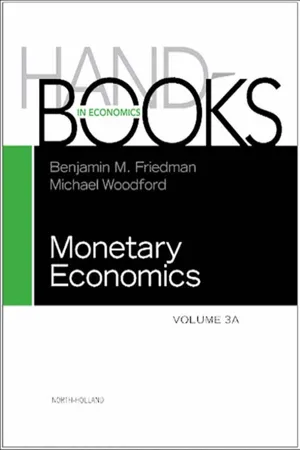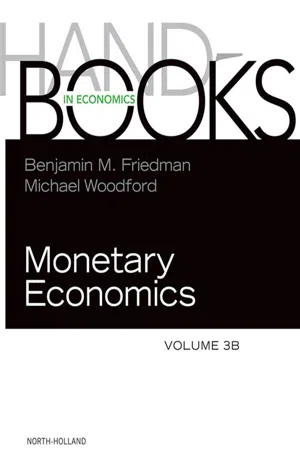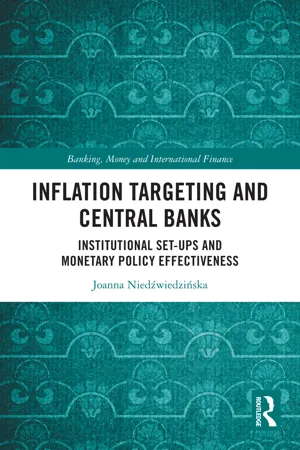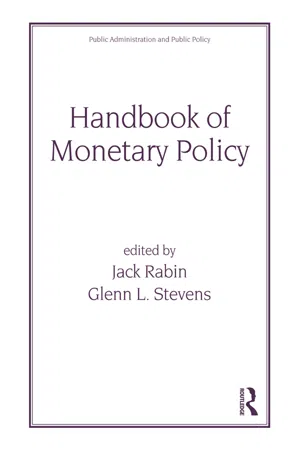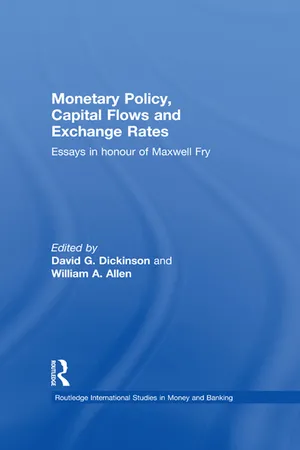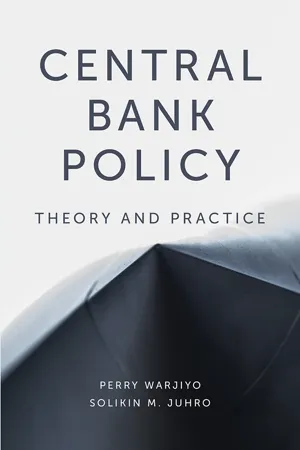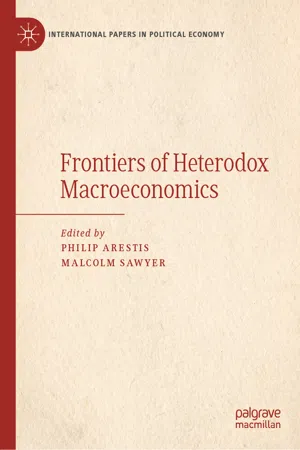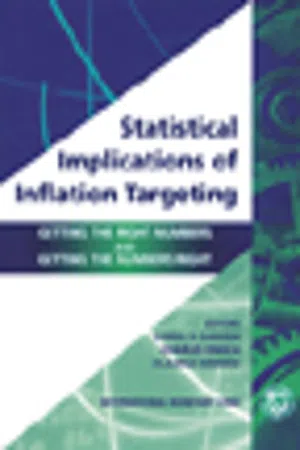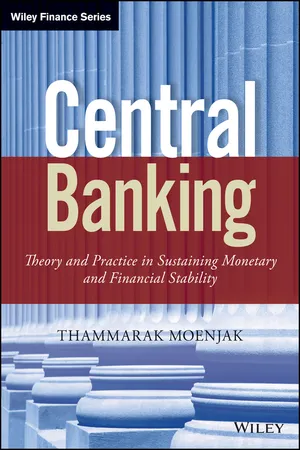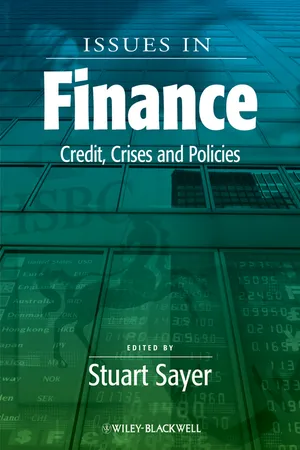Economics
Flexible Inflation Targeting
Flexible inflation targeting is a monetary policy framework where a central bank sets an explicit target for inflation, but allows for flexibility in achieving that target. This approach gives the central bank some discretion to consider other economic factors, such as output and employment, when making policy decisions. It aims to provide a balance between price stability and supporting overall economic growth.
Written by Perlego with AI-assistance
Related key terms
11 Key excerpts on "Flexible Inflation Targeting"
- eBook - ePub
- Benjamin M. Friedman, Michael Woodford(Authors)
- 2010(Publication Date)
- North Holland(Publisher)
Monetary Economics , Vol. Suppl., No. 2011ISSN: 1573-4498doi: 10.1016/B978-0-444-53454-5.00010-4Chapter 22 Inflation Targeting*Lars E.O. Svensson, Sveriges Riksbank and Stockholm UniversityAbstract AbstractInflation targeting is a monetary-policy strategy characterized by an announced numerical inflation target, an implementation of monetary policy that gives a major role to an inflation forecast that has been called forecast targeting, and a high degree of transparency and accountability. It was introduced in New Zealand in 1990, has been very successful in terms of stabilizing both inflation and the real economy, and as of 2010 has been adopted by about 25 industrialized and emerging-market economies. This chapter discusses the history, macroeconomic effects, theory, practice, and future of inflation targeting.JEL classification E52 E58 E42 E43 E47Keywords Flexible Inflation Targeting Forecast Targeting Optimal Monetary Policy Transparency1 Introduction
Inflation targeting is a monetary-policy strategy that was introduced in New Zealand in 1990. It has been very successful, and as of 2010 had been adopted by approximately 25 industrialized and nonindustrialized countries. It is characterized by (1) an announced numerical inflation target, (2) an implementation of monetary policy that gives a major role to an inflation forecast and has been called forecast targeting, and (3) a high degree of transparency and accountability (Svensson, 2008 - eBook - ePub
- Benjamin M. Friedman, Michael Woodford(Authors)
- 2010(Publication Date)
- North Holland(Publisher)
Importantly, there is no evidence that inflation targeting has been detrimental to growth, productivity, employment, or other measures of economic performance in either developed and developing economies. Inflation targeting has stabilized long-run inflation expectations. No country has abandoned inflation targeting after adopting it (except to join the Euro Area), or even expressed any regrets. For both industrial and non-industrial countries, inflation targeting has proved to be a most flexible and resilient monetary-policy regime, and has succeeded in surviving a number of large shocks and disturbances, including the recent financial crisis and deep recession. 15 The success is both absolute and relative to alternative monetary-policy strategies, such as exchange-rate targeting or money-growth targeting. 3 THEORY As mentioned earlier, in practice, inflation targeting is never “strict” but always “flexible,” in the sense that all inflation-targeting central banks not only aim at stabilizing inflation around the inflation target but also put some weight on stabilizing the real economy; for instance, implicitly or explicitly stabilizing a measure of resource utilization such as the output gap between actual output and potential output. Thus, the target variables of the central bank include not only inflation but other variables as well, such as the output gap. The objectives under Flexible Inflation Targeting seem well approximated by a quadratic loss function consisting of the sum of the squared inflation deviation from target and a weight times the squared output gap, and possibly also a weight times the squared policy-rate change (the last part corresponding to a preference for interest-rate smoothing). Because there is a lag between monetary-policy actions (such as a policy-rate change) and its impact on the central bank’s target variables, monetary policy is more effective if it is guided by forecasts - eBook - ePub
Inflation Targeting and Central Banks
Institutional Set-ups and Monetary Policy Effectiveness
- Joanna Niedźwiedzińska(Author)
- 2021(Publication Date)
- Routledge(Publisher)
Of course, deciding at which point a change already means a new regime is difficult, in particular when analysing inflation targeting, since this strategy from the very beginning has been continuously evolving (Niedźwiedzińska et al., 2019, pp. 42–72). Given the fact that in the 1990s, IT was tried as a pragmatic solution to the problem of heightened inflation without deep theoretical foundations, and only after proving to be quite successful and gaining popularity which motivated economists to look for reasons behind its effectiveness, this constant evolution should not be surprising. Apart from that, when adopting the framework, many inflation targeters were testing some innovative solutions that sometimes turned out to be beneficial and sometimes were abandoned (Ciżkowicz-Pękała et al., 2019, pp. 73–181). For that reasons, although key IT features are commonly known, they are defined in quite general terms and leave room for various interpretations. Indeed, the past three decades have shown that flexibility should be viewed as one of the important aspects of an inflation targeting regime.Although sometimes it may not be easy to decide what can and what cannot be treated as compatible with IT, some proposals for reforming the currently used monetary policy frameworks clearly do not violate inflation targeting constituting features. Raising inflation targets is definitely one of them (Blanchard et al., 2010; Ball, 2014).77 Despite not enjoying much support among central bankers (Bernanke, 2019, p. 5), not least due to its likely inconsistency with the mandate of price stability, the idea of increasing the targeted level of inflation in advanced economies from the most typical 2% to 4% has recently been proposed again (Posen, 2019, pp. 68–69).78 Its key benefit would be to provide more space for lowering nominal interest rates before reaching the ZLB.At the same time, recognising the fact that inflation targeting was introduced as a framework to fight too high inflation, some economists have raised doubts about whether it can be equally suitable for fighting too low price growth, which would suggest the need to go beyond IT (Heise, 2019, p. 77). Thus, a number of alternative targeting rules have been proposed. Similarly to the case of raising inflation targets, their main motivation is to deal with the problem of the ZLB. - eBook - ePub
- Jack Rabin(Author)
- 2020(Publication Date)
- Routledge(Publisher)
Conducting Monetary Policy with Inflation TargetsGeorge A. KahnVice President and Economist, Federal Reserve Bank of Kansas City, Kansas City, MissouriKlara ParrishAssistant Economist, Federal Reserve Bank of Kansas City, Kansas City, MissouriReprinted from: Federal Reserve Bank of Kansas City Economic Review, v. 83, n. 3 (Third Quarter 1998) 5–32.Since the early 1990s, a number of central banks have adopted numerical inflation targets as a guide for monetary policy. The targets are intended to help central banks achieve and maintain price stability by specifying an explicit goal for monetary policy based on a given time path for a particular measure of inflation. In some cases the targets are expressed as a range for inflation over time, while in other cases they are expressed as a path for the inflation rate itself. The measure of inflation that is targeted varies but is typically a broad measure of prices, such as a consumer or retail price index.At a conceptual level, adopting inflation targets may necessitate fundamental changes in the way monetary policy responds to economic conditions. For example, inflation targeting requires a highly forward looking monetary policy. Given lags in the effects of monetary policy on inflation, central banks seeking to achieve a target for inflation need to forecast inflation and adjust policy in response to projected deviations of inflation from target. But central banks without an explicit inflation target may also be forward looking and equally focused on a long-run goal of price stability. Thus, at a practical level, adopting inflation targets may only formalize a strategy for policy that was already more or less in place. If so, targets might improve the transparency, accountability, and credibility of monetary policy but have little or no impact on the way policy instruments are adjusted to incoming information about the economy. - William Allen, David Dickinson(Authors)
- 2002(Publication Date)
- Routledge(Publisher)
During the quarter-century since then, the rate of inflation has been reduced tenfold, from over 25 per cent to below 2.5 per cent. The fall in the rate of inflation has not been steady or continuous. There have been a number of crises, and a number of different monetary policy techniques have been used. Inflation targeting is the latest of them, adopted after the United Kingdom left the European Exchange Rate Mechanism, and it has been the longest-lasting. The procedures of inflation targeting are still evolving in the light of continuous learning through experience.Inflation targeting is based on the assumption that low inflation is the single proper objective of monetary policy. That assumption is based, in the United Kingdom, on the unhappy experience of trying to pursue other objectives with monetary policy. It is beyond the scope of this paper to justify the assumption that price stability should be the proper objective of monetary policy. Briault (1995) sets out the arguments: the public debate in the United Kingdom has become much less heated in the last few years, perhaps largely because low inflation has been accompanied during those years by strong economic growth and falling unemployment, so that there has been no sign of a conflict between low inflation, high growth and high employment.Nevertheless, there have been some complaints in the United Kingdom that the fact that the central bank is pursuing an inflation target means that it is not concerned about output and employment. This is a misconception, because the inflation target is symmetrical. It is just as serious a policy error for inflation to be below target as it is for it to be above target, and if inflation is expected to be below target, it is the Bank of England’s duty to ease monetary policy. Moreover, the Bank of England is required by law to support the Government’s economic policy, including its objectives for growth and employment, subject to the overriding objective of maintaining price stability.- eBook - ePub
Central Bank Policy
Theory and Practice
- Perry Warjiyo, Solikin M. Juhro(Authors)
- 2019(Publication Date)
- Emerald Publishing Limited(Publisher)
(1) In the near term and with maintained macroeconomic stability, there can be a potential shift in the focus of monetary policy toward greater emphasis on economic growth. This fundamentally confirms the idea that achieving price stability as the overriding goal does not imply that the central bank can neglect efforts to maintain economic growth momentum. In contrast, in the near term, the preference of monetary policy can be oriented toward specific considerations that maintain the economic recovery process, while striving toward price stability in the long term as a prerequisite for sustainable economic growth.(2) Congruent with some of the lessons garnered from the GFC, a more flexible monetary policy response is required when considering the strategic role and dynamics of the financial sector. To that end, an optimal and effective monetary and macroprudential policy instrument mix is required. Despite the need for greater consideration of the strategic role and dynamics of the financial sector, the strategic monetary policy framework in Indonesia maintains price stability as the main factor underlying the monetary policy response.(3) In terms of policy implementation, flexibility also contains institutional aspects considering that the root of the problems faced by the central bank is not always within the scope of monetary policy influence. Therefore, strong policy coordination between BI and the Government is imperative.It should be reiterated that, in the context of ITF implementation, BI already implicitly applies Flexible ITF, meaning that in the near term, BI strives to stabilize inflation and the real economy together. ITF flexibility is reflected in the orientation to achieve the overriding goal, namely inflation, but while also paying due consideration to the dynamic performance of other macroeconomic variables in the short term, such as economic growth, exchange rates, and financial sector developments. To that end, five important factors are always considered when determining the policy rate, namely: (1) the two-year inflation forecast and consistency with the inflation target; (2) the two-year economic growth forecast; (3) the exchange rate forecast and affecting factors (including capital flows), as well the impact on the inflation and economic growth forecasts; (4) bank credit and interest rates; and (5) asset valuation in the financial sector. The first two factors maintain BI Rate consistency with attainment of the inflation target, while considering the inflation-growth trade-off to maximize public welfare. The final three factors balance monetary stability and financial system stability, while also assessing the monetary policy transmission mechanism. - eBook - ePub
- Philip Arestis, Malcolm Sawyer, Philip Arestis, Malcolm Sawyer, Philip Arestis, Malcolm Sawyer(Authors)
- 2019(Publication Date)
- Palgrave Macmillan(Publisher)
(2018) focus more strongly on the different effects between developed and less-developed economies. The fiscal stance in terms of debt to GDP ratios improves in all targeters, although as mentioned above, developing economies with high debt to GDP ratios have no incentive to introduce inflation targeting. The results are again dispersed in regard to exchange rate volatility. Developed economies face an increase in exchange rate volatility, while the situation improves in developing economies. Aizenman et al. (2011) come to similar results when focusing on less developed inflation targeters only. Summing up, it can be stated that besides of the mixed picture on the success in empirical studies, case studies suggest that inflation targeting as a monetary scheme even if it is not a framework that can be implemented in similar modes but requests a national specific modelling, holds what it promises and the theoretical background of inflation targeting per se is not questioned. Furthermore, the global financial meltdown shed light on the structural deficits of the system of inflation targeting, which led to the demand for reshaping the structure even within the orthodox thinking. Two major conclusions are drawn from a mainstream perspective after the financial crisis (Reichlin and Baldwin 2013): Inflation targeting is an adequate monetary structure to ensure price stability and enables economic development that needed a revision after the crisis—“fix it don’t scrap it” (p. 28). The macroeconomic environment after the global crisis request a stronger focus on credibility to determine expectations to cope with a more fragile banking sector and heavily indebted national states. Consequently, numerous proposals for revision were brought forward, which aim to maintain the core setting of the model within the New Synthesis framework, but adapt it to the changed environment after the financial crisis - eBook - ePub
- Carol Carson, Claudia Dziobek, and Charles Enoch(Authors)
- 2002(Publication Date)
- INTERNATIONAL MONETARY FUND(Publisher)
The introduction of inflation targeting in South Africa was motivated by the desire for financial stability, which is an important precondition for sustainable high growth and employment creation. By establishing and maintaining financial stability, the monetary authorities make their unique contribution to general economic development in South Africa. If financial institutions and markets are uncertain or unstable, it is difficult to produce, consume, invest, and therefore to increase employment. The emerging market financial crisis in 1997 and 1998 has also clearly illustrated that foreign investment can be withdrawn easily and in large amounts from countries that investors perceive as high-risk destinations. Moreover, it is difficult for a country with a high rate of inflation to remain competitive in a global environment where more and more countries have already successfully reduced inflation to low levels.The government of South Africa decided to set an inflation target as part of a new approach to monetary policy and price stabilization because such a framework is expected to have certain advantages:- making the objective of monetary policy clear and thereby improving planning in the private and public sectors;
- forming part of a formalized, coordinated effort to contain inflation in pursuit of the broader economic objective of sustainable high economic growth and employment creation;
- helping to focus monetary policy and enhancing the accountability of the central bank to the public; and
- providing an anchor for expectations of future inflation, which should influence price and wage setting.
Inflation targeting in South Africa is characterized by an announcement of a numerical target for the inflation rate that is intended to be achieved over a specific time period. In this definition it is important to note that inflation targeting is a framework, not a rule; that the numerical rate is made public; and that a definite time horizon is specified.Although the achievement of the target becomes the overriding objective of monetary policy in an inflation-targeting framework, the adoption of the new framework does not mean that the central bank is forced to apply rigid rules and is left without any discretion.In the application of inflation targeting in South Africa, allowance is made for serious supply shocks. Some discretion must be exercised in order to avoid costly losses in terms of output and jobs. The South African Reserve Bank has to monitor economic developments closely to determine the origin and likely impact of such supply shocks, including developments affecting the terms of trade of the country or large disruptive international capital flows. Shocks could also arise from natural disasters. If such developments do occur, the public is informed of the likely consequences of attaining the monetary policy objective. - eBook - ePub
- Sergio Rossi(Author)
- 2007(Publication Date)
- Routledge(Publisher)
The theory of inflation targeting is a result of the long-lasting ‘rules versus discretion’ debate in monetary policy, which more recently gave rise also to the calls for central bank independence. This debate is at least 200 years old and could be traced back to the controversy between the banking and currency schools that broke out at the beginning of the nineteenth century over the constitution of the Bank of England (see e.g. Fetter 1965). It has also been an issue during the twentieth century, as Keynes’s (1932) and Simons’s (1936) argument testifies well before the Kydland and Prescott (1977) seminal contribution led to today’s central bank independence as an improved version of the rule-based approach to monetary policy argued, for instance, by Friedman (1968).In fact, inflation targeting is not a rule, as it does not provide a simple and mechanical framework for the conduct of monetary policy. Quite to the contrary, it requires monetary policy makers to use structural models of the economy as well as their own judgement, and to consider all available information to design the policy that is more likely to hit the target rate of inflation and be conducive to good economic performance. This allows indeed some discretion to monetary policy makers. Inflation targeting may be defined therefore as ‘a framework for policy within which “constrained discretion” can be exercised’ (Bernanke et al. 1999: 22). This makes it a good compromise for both advocates of policy rules and partisans of policy discretion. As Bernanke et al. (1999: 6) point out, ‘[b]y imposing a conceptual structure and its inherent discipline on the central bank, but without eliminating all flexibility, inflation targeting combines some of the advantages traditionally ascribed to rules with those ascribed to discretion.’Now, critics of inflation targeting often argue that both the ineffectiveness and the rather weak economic performance of this regime is the direct result of a hierarchical mandate attributed to inflation-targeting central banks (see, notably, Meyer 2002, Bernanke 2003). According to these authors, a dual mandate allows monetary policy to contribute to lowering output variability without thereby putting the price stability goal at stake. In fact, the problem of inflationtargeting regimes is not merely institutional, but analytical essentially. To be sure, even with a dual mandate attributing equal footing to output and price level stability, the problem remains that a symptom-based definition of inflation cannot help going to the root of this phenomenon to get rid of it eventually. Clearly, the problem is not merely that a central bank’s policy success is currently established on its ability to meet inflation targets rather than output growth targets, as Arestis and Sawyer (2003: 5) maintain. Even if one were to succeed in changing the political criteria by means of which monetary policy is both designed and assessed today, one could still not make sure that central banks contribute to economic performance according to the social preferences as regards inflation and output outcomes. - eBook - ePub
Central Banking
Theory and Practice in Sustaining Monetary and Financial Stability
- Thammarak Moenjak(Author)
- 2014(Publication Date)
- Wiley(Publisher)
impossible trinity. The impossible trinity has been one key reason why numerous central banks in Europe, Asia, and Latin America have been abandoning exchange rate targeting as their monetary policy rule. In a world of freer international capital flows and diverging economic cycles, many of these central banks often find it hard to maintain a fixed exchange rate and fine-tune the domestic economy at the same time. We discuss issues relating to the exchange rate in more detail in Chapters 8 to 10.6.3 MONEY SUPPLY GROWTH TARGETING
As the name suggests, a money growth targeting rule requires that the central bank set a target rate for growth of the money supply. According to this rule, if the central bank keeps money supply growth at a target rate that is consistent with that of real economic activity, then inflation should be relatively low and stable. In the 1970s, central banks around the world had to grapple with the effects of the breakdown of the Bretton Woods system. While many central banks decided to keep their exchange rates fixed to the U.S. dollar or the German mark,11 by the 1980s a number of advanced economy central banks, including those of the United States and Germany, had adopted money growth targets as a guide for their monetary policy actions.12A Stylized Model of Money Supply Growth Targeting
Money supply growth targeting is based mainly on the quantity theory of money discussed in Chapter 5. Recall the equation of exchange - eBook - ePub
Issues in Finance
Credit, Crises and Policies
- Stuart Sayer, Stuart Sayer(Authors)
- 2011(Publication Date)
- Wiley-Blackwell(Publisher)
Ortega and Rebei (2006) address this issue in a multi-sector framework. They also analyse the relative advantages of PT and IT, and of a weighted average of the two. They construct a small open-economy model of the Canadian economy with traded and non-traded sectors, and with nominal-price rigidities in both sectors (and differential pricing of traded goods between domestic and export markets), as well as nominal-wage rigidities. No clear advantages of PT over IT emerge, and it is difficult to discern the key assumptions in their model that are responsible for their results. Aoki (2001) builds a somewhat simpler two-sector model. One of the sectors is a competitive, flexible-price sector and the other is a sticky-price sector with monopolistically competitive firms. Aoki finds that the optimal monetary policy in this framework entails the complete stabilisation of inflation in the sticky-price sector alone. In so far as relative prices must fluctuate in order to reduce fluctuations in the output gap, this allows prices in the flexible-price sector to do all of the adjusting.While Erceg et al. (2000) do not focus on the choice of price index, their results are suggestive. They build a forward-looking model with both nominal-wage and nominal-price rigidities. They show that it is optimal to target a weighted average of wage inflation and price inflation. The relative weight on wage inflation versus price inflation is related directly to the average length of nominal-wage rigidity compared to nominal-price rigidity. Their results are compatible with those of Aoki, and can be interpreted as a generalisation of his results, since the relative degree of the rigidity of prices and wages is variable in their model.These results imply that PT using the full CPI will in general not be optimal. Monetary policy should focus primarily on reducing fluctuations in prices that are relatively more rigid, while allowing more flexible prices to adjust relative to these rigid prices.29 This solution represents a compromise. It facilitates relative price adjustment across different broad categories of goods in the face of real shocks, while at the same time dampening inefficient relative price fluctuations across different monopolistic producers of the same category of good. Even though the Bank of Canada does not directly target core inflation, looking closely at a less volatile component of the overall price index is in keeping with the spirit of this result.5.4 The Transition from Inflation Targeting to Price-level TargetingMost formal comparisons of the welfare properties of the IT and PT regimes are built on the premise that individuals understand perfectly the workings of both regimes so that their expectations are completely rational. These comparisons ignore the costs associated with a transition from an IT regime to a PT regime, which would involve the private sector learning about the workings of the regime. The learning process itself could mean expectations that are more dispersed across individuals in the short run. The adjustment in expectations would present communication challenges to the central bank that is effecting the regime change: this is discussed in the next section.
Index pages curate the most relevant extracts from our library of academic textbooks. They’ve been created using an in-house natural language model (NLM), each adding context and meaning to key research topics.
